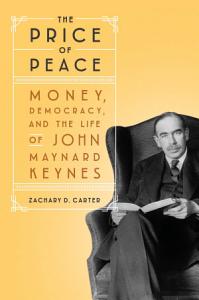The Price of Peace
Full Title: The Price of Peace: Money, Democracy, and the Life of John Maynard Keynes
Author / Editor: Zachary D. Carter
Publisher: Random House, 2020
Review © Metapsychology Vol. 25, No. 12
Reviewer: John D. Mullen
A 2006 poll, associated with George Mason University, posed a question. Which 20th century economist made the greatest contribution to the understanding of how economies work? John Maynard Keynes (1883-1946) was ranked number 1, defeating Friedrich Hayek, Keynes’s prime rival in his lifetime by, 7 to 1. Milton Friedman, his rival nowadays for hearts and minds in the US, was outpointed by 10 to 1. There’s much to contest over such a poll; the political right being indignant and the progressive left complacent in its victory. Still, Keynes upended political economy, as studied and especially as practiced, as thoroughly as Einstein disrupted a long-settled physics during about the same era. Zachary Carter’s wonderful book tells the story of not only Keynes’s life and ideas (1883 – 1946), but also the life of Keynesianism after his departure.
As a young man of brilliance, wit and ambition, Maynard – as his friends called him – entered Cambridge University in England. He was drawn first to philosophy and quickly made his way, while still a student, into the university’s highest intellectual circles, making of his friends, Bertrand Russell, G. E. Moore, the eccentric Ludwig Wittgenstein and the young genius, Frank P. Ramsey. As a result of the likes of Moore’s Principia Ethica (1903), Russell (and Whitehead’s) Principia Mathematica (1913) and Wittgenstein’s Tractatus Logico Philosophica (1921), Cambridge was then the center of English-speaking philosophy worldwide. Keynes’s own work at this time was an important contribution to that philosophy, A Treatise on Probability (1921). His interest in the arts; poetry, literature, music and painting led him to become an active member of the avant garde Bloomsbury group along with Virginia Woolf, Lytton Strachey, E. M. Forster, Duncan Grant and others.
Keynes, as economist, was not an armchair thinker. His contributions were developed while he was an important participant in three great crises; the aftermath of Germany’s defeat in WW I, the Great Depression and dissatisfactions of the laboring class in Great Britain. Keynes took part, one way or another, in these events as a government bureaucrat, an advisor to prime ministers, as critic and as a negotiator. The author, Zachary Carter tells these stories brilliantly, and with deep detail. I was impressed, reading this book, by how much I’d neglected to learn over my many years.
It is important to note as well, that the deep and wide effects of Keynes’s ideas were not restricted merely to economic theory and practice. It was his revolution in economics that necessitated and produced a fundamental shift in how we perceive the legitimate role of government. Keynes’s ideas required that government accept a wide-ranging responsibility for guiding the national economy, a commitment that was, and is, inconsistent with largely unregulated markets. As I write today, in the midst of a terrible pandemic that has prompted a widespread economic decline, headlines are filled with reports of the $1.9 trillion relief and stimulus package passed by the US Congress. This would have been unthinkable without the changes wrought by Keynes’s analyses, proposals and theoretical constructions. As none other than Richard Nixon was purported to have said in 1971, “We are all Keynesians Now.” (His actual statement was, “I am now a Keynesian in economics.”)
There are many interesting sub-stories in Carter’s book; The part played by Keynesian ideas in the US up to the Obama administration, Keynes’s relationship with the artist Duncan Grant and other men in the Bloomsbury group, his later and passionate marriage to Lydia Lopokova, a Russian ballerina, his prescient critique of the punishment of Germany after “The Great War”, his important participation in the Bretton Woods Conference (1944) in New Hampshire, his fight to undermine of the Gold Standard in England, and much more. I highly recommend this book to those interested in these matters.
John D. Mullen is a philosopher living in a mostly rehabbed timber-framed house Dresden, Maine. He is the author, with Byron M. Roth, of Decision Making, It’s Logic and Practice, a book on logic and rhetoric, Hard Thinking: The Re-Introduction of Logic to Everyday Life, and the widely read, Kierkegaard’s Philosophy: Self-Deception and Cowardice in Everyday Life. His stories are sprinkled about the web and his novel, The Woman Who Hated Philosophers, Swallow Tail Press, was published in 2017. He is presently at work on a novella, Fibonacci’s Child.
Categories: Memoirs
Keywords: philosophy, economics

